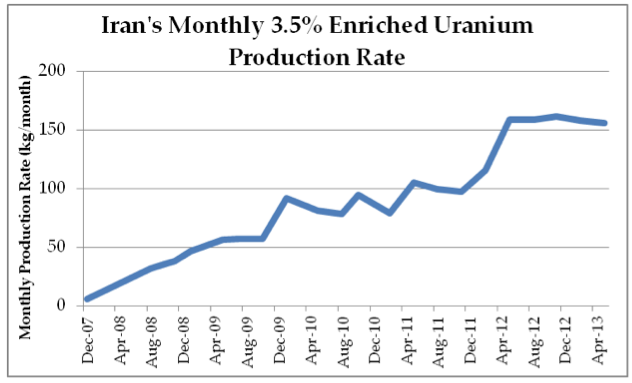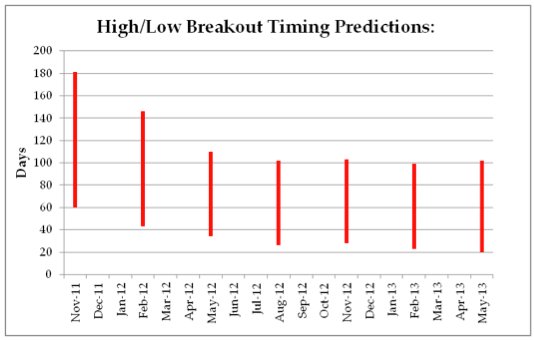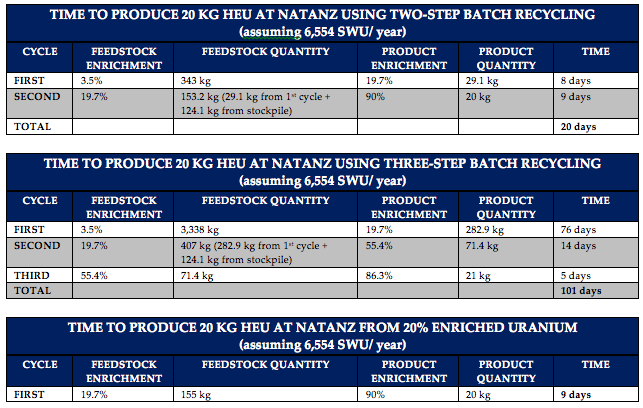Update on Iran’s Nuclear Program
Summary
The latest report from the International Atomic Energy Agency (IAEA), released on May 22, demonstrates that Iran is continuing a trend first identified in February 2013: slowing down and speeding up elements of its nuclear program to evade red lines set by U.S. and Israeli leaders, while drawing closer to nuclear weapons capability.
On the one hand, Iran continues to draw down its stockpile of 20% enriched uranium to produce fuel for its Tehran Research Reactor. This move suggests that Iran is trying to decelerate its nuclear program, specifically by pushing back the date when it accumulates enough 20% enriched uranium ? 155 kilograms ? to produce, with further enrichment, sufficient highly enriched uranium for a nuclear device. This latest draw down pushes back the date when Iran will amass 155 kilograms of 20% enriched uranium by roughly a month, into early August 2013, assuming it remains on its current trajectory and does not further deplete its stockpile.
Yet, Iran also appears to be expanding the Natanz Fuel Enrichment Plant with additional centrifuges, including next-generation models. In the last three months, Iran has added almost 900 centrifuges to Natanz. More disturbingly, Iran continues to install advanced centrifuges, known as the IR-2m model, at Natanz. These machines could prove twice as effective, or more, at enriching uranium than the current IR-1 model. The IAEA report shows that in the last three months Iran has installed, or is in the process of installing, 509 of these new machines, for a total of 689.
Iranians are preparing to elect a new president from among eight regime-approved candidates on June 14. Diplomacy is on pause during this spectacle, in the hopes that whoever emerges victorious will be more willing to negotiate an end to Iran’s nuclear standoff. In the meanwhile, however, ever more centrifuges continue to spin, bringing Iran ever closer to the threshold of undetectability: the capability to produce enough highly-enriched uranium for a nuclear device faster than the IAEA would be able to detect it and the United States would be able to respond.
For this reason, the continued application of pressure according to the triple-track strategy of diplomacy, sanctions and credible and visible preparations of the military option, as laid out by the Bipartisan Policy Center’s (BPC) Iran Task Force, co-chaired by Senator Charles Robb and General (ret.) Charles Wald, remains necessary. The House of Representatives is currently considering bipartisan legislation that would tighten sanctions against Iran, eliminate the president’s ability to grant waivers from sanctions, and put in place a mechanism for assessing Iran’s nuclear progress. Passing this bill could be an important step towards preventing a nuclear weapons-capable Iran.
Additional details and highlights from the IAEA report include:
Enrichment Rate and Output Remains at All-Time High
Production of 3.5% enriched uranium remains at all time high level, triple pre-Stuxnet rate.*
– Between Feb. 2013 and May 2013, Iran produced an average of 156 kg/month.
- Effectively same rate for the last year;
- Fastest previous rate (Feb. 2012): 115 kg/month;
- 2010 average: 83 kg/month;
- 2009 average: 56 kg/month.
– Known 3.5% enriched uranium stockpile reaches 4,297 kg. At current enrichment level can fuel nuclear reactor; enough, when enriched to 90%, for at least two nuclear weapons.
Production rate of 20% enriched uranium fastest ever.
– Combined (Fordow + Natanz) 20% enriched production rate: 10.4 kg/month;
- 2012 average: 8.8 kg/month
- 2011 average: 2.6 kg/month
Iran Draws Down 20% Enriched Uranium Stockpile
Iran removes 19 kg 20% enriched uranium for processing into reactor fuel.
– Fourth time in last year Iran has done this, for total of 95 kg removed:
- May 2012: 30 kg removed;
- Nov. 2012: 36 kg removed;
- Feb. 2013: 10.2 kg removed.
- May 2013: 18.8 kg removed.
– Iran has produced 219.3 kg of 20% enriched uranium.
– But only 124.1 kg remain in its stockpile.
– 155 kg of 20% enriched uranium is minimum needed, with further enrichment, for a nuclear weapon.
Expansion of Enrichment Facilities
Expansion of Natanz continues; number of operating centrifuges holds steady.
– 8,692 centrifuges operating;
– Down from 9,156 centrifuges operating in November 2012.
But highest number of installed centrifuges at Natanz ever, more planned.
– 13,555 IR-1 centrifuges installed;
– Up from 12,669 in Feb. 2013;
– Preparatory work for additional 7,544 centrifuges already completed.
Iran begins installing next-generation centrifuges at Natanz.
– 689 IR-2m centrifuges and casings have been installed.
– Up from 180 in Feb. 2013.
– Iran informed IAEA that it plans to install 2,952 IR-2m centrifuges at Natanz.
– IR-2m centrifuges are designed to twice as productive as the currently deployed IR-1 model.
– Iran is also experimenting with even more advanced IR-4, IR-6, and now for the first time ever, IR-5 centrifuge models at its R&D facility.
Fordow facility completed.
– Number of operating centrifuges steady at 696;
– But all remaining 2,088 centrifuges installed, tested and prepared for enrichment, could become operational imminently.
Production of 20% enriched uranium could triple when Fordow fully-operational.
– Currently, 696 centrifuges at Fordow produce 7.4 kg of 20% enriched per month;
– Once operational, remaining 2,088 centrifuges could produce additional 22.2 kg of 20% enriched per month;
– Total 20% enriched production (fully-operational Fordow + Natanz) could reach: 32 kg/month.
Iranian Defiance Continues
- Iran’s continued enrichment of uranium defies five United Nations Security Council resolutions.
- Iran’s construction of the Arak heavy water reactor, which is nearing completion, also contravenes IAEA and UNSC resolutions..
- Iran continues to deny IAEA inspectors access to suspected explosives testing site at Parchin, which has now been leveled and paved over.
Effect on Timing
With only minor changes to Iran’s production rate of 3.5% enriched uranium and 20% enriched uranium stockpile compared to the previous reporting period, the time Iran would need to produce enough fissile material for a nuclear weapon has not changed dramatically. However, the developments detailed by the IAEA suggest the potential for major advances.
Depending on the method used, Iran could produce 20 kilograms of highly enriched uranium, enough for a weapon, within 20 to 101 days.**
– In November 2012, that range was between 28 and 103 days.
– In November 2011, that range was between 60 and 180 days.
That window could fall to just 9 days by August 2013, when Iran could amass 155 kg of 20% enriched uranium.***
Developments to watch for that could have major impact on timing:
– Additional centrifuges at Fordow plant begin operating;
– Additional centrifuges at Natanz plant begin operating;
– IR-2m centrifuges at Natanz are installed and operating.

For a larger version of the chart above, click here.




For larger versions of the tables below, click here.


* For enrichment, uranium must be in gas form as uranium hexafluoride (UF6). The IAEA reports its data in kilograms of UF6. However, for this paper, we will refer to solid form uranium. One kilogram of UF6 yields roughly 0.67kg uranium metal.
** This range depends on whether Iran uses a two- or three-step batch recycling process to produce highly enriched uranium for a nuclear weapon and is based upon the work of Greg Jones at the Nonproliferation Policy Education Center. Both scenarios assume the use of the Natanz Fuel Enrichment Plant at its current production rate and drawing upon Iran’s current stockpiles of 3.5% and 20% enriched uranium. For a more detailed explanation, see here.
*** If Iran continues to produce 20% enriched uranium at its current rate, by May 2013 it will have stockpiled 155kg, the minimum needed to produce HEU for a nuclear weapon.
| Report Overview.pdf | 162 KB |
| Uranium Stockpile.pdf | 187.4 KB |
Share
Read Next
Support Research Like This
With your support, BPC can continue to fund important research like this by combining the best ideas from both parties to promote health, security, and opportunity for all Americans.
Give Now